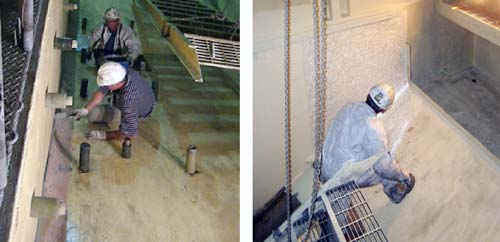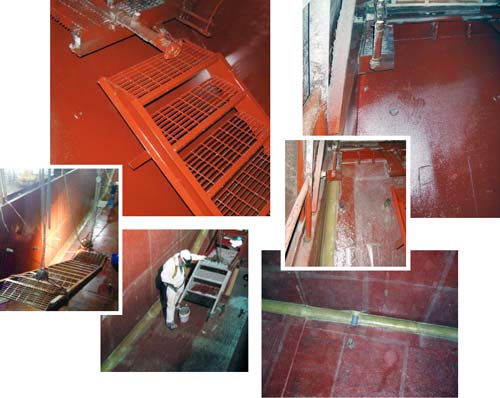CASE STUDY
Participating Vendors:
![]()
Project: Automotive Phosphate
Stage 2 and 4 Tank & Housing
Refurbishment Project

The Stage 2 and 4 Tanks & Housings were in severely deteriorated condition at the time this Refubishment Project was funded. The upper housing had many perforations before the sandblasting operation for metal preparation. Many holes had to be covered and filled with fiberglass to restore the integrity of the enclosure.
The Stage 2 steel alkaline cleaner dip tank at a Midwest automotive plant had problems with early corrosion issues in the tank and housing. The operating conditions in this tank were alkaline cleaned at 130º F immersion temperatures. RO water was used in make up water adding to the corrosion issue. The tank is also boiled out (chemically cleaned) from time to time with strong alkaline solution at 150º F to remove oil and grease and sludge.
The experts at Chemical Containment and Advanced Polymer Coatings were consulted to come up with a polymer lining solution for this challenging application. A plan was initiated with very innovative ideas to provide a long term lining solution to protect and prolong the life of the Stage 2 and 4 Tanks & Housings for a decade or more.
![]()

Existing Stage 2 Eductor Headers were extremely fouled with oily sludge resulting in very poor flow and distribution of pumped process solution.
 Stage 4 Steel stairs, handrails, and internal piping were extremely corroded.
Stage 4 Steel stairs, handrails, and internal piping were extremely corroded.
Scope of Work
On June 26, 2010 the contractor Ultimate Corrosion Control Inc. commenced the job at 7PM and completed the job July 3, 2010 at 7AM. The scope of their work was to abrasive blast and line two tanks and the housings over those tanks. This report describes the Stage 2 Alkaline Cleaner tank, the more technical and critical portion of the job.
Ultimate Corrosion Control (UCC) furnished workers that performed quality work at the plant previously and who are experienced and knowledgeable in the surface preparation and application of high performance industrial coatings.

Ultimate Corrosion Control provided extemely quick
and efficient turn around
by effectively staging
the project.
Top row, left to right: Removal of existing fittings; water-jet swirls on tank walls shows the many layers and coatings being removed; protective cover over tank during blasting/coating.
Lower photos, left to right: air bag for collecting blasting debris; debris collection and removal system.
Cleaning & Abrasive Blasting
All surfaces to be lined surface prior to abrasive blasting were cleaned by with a hydro-jet at 30,000 psi. All surfaces were free from contamination from grease, oils or salts.
After cleaning, the surface was abrasively blasted to SSPC-SP5 (NACE #1, SA3) white metal finish with 3 mil profile. Black Beauty 1240 was used in accordance to specification of the coating manufacturer, Advanced Polymer Coatings. The blasting debris was collected in vacuum boxes and the airborne contaminates collected in large dust bags.
The tank was cleaned and primed in a fashion that did not compromise the abrasive blast. Humidity was monitored and was 65% or lower during coating operations and the substrate temperature was within the range 10º to 40º C and 3º C of the dew point.
Primer Coating Applied
UCC applied the first spray coat of ChemLINE 784-32 (red) to the floors and walls of the dip and weir tanks and the suspended stairs at 6-8 mils (150-200) microns wet film thickness in accordance to the specification.
UCC allowed the (red) prime coat to cure to the B Stage and applied one coat of mixed clear Siloxirane resin and hardner and pressed one layer of fiberglass mat into the wet basecoat and fully saturated the fiberglass reinforcement.
The fiberglass coves, fiberglass couplings and eductor header outlets were installed using thickned ChemLINE 784-32. This was allowed to cure to B Stage.

Added between the primer coating and the final coating, fiberglass reinforcement improves the lining’s resistance to damage.
Fiberglass Reinforcement Applied
Once the prime coat was completed in both tanks, UCC applied fiberglass reinforcement prior to the full coat application. With fiberglass reinforcement the lining will be resistant to scrapes, and gouges from parts falling, dragging and piling up in the tank bottom and sides
About ChemLINE 784-32 Final Coating
The Advanced Polymer Coating called ChemLINE 784-32 was specified because the vinyl ester lining had failed in this tank and a more durable heat resistant lining was desired. ChemLine 784/32 will significantly improve lining performance for the Alkaline Cleaner Stage over the vinyl ester installed previous.

ChemLine 784/32‘s Higher Cross-Link Density (shown in the graphic above) as compared to the vinyl ester will provide:
- Higher Chemical Resistance
- Higher Toughness
- Higher Heat Resistance
- Higher Resistance to Abrasion

Above, Ceramic insullation was used to control humidity and temperature within the tank.
Left, A top coat was applied using ChemLINE 784/32.
Full Coat Applied
A second full coat of ChemLINE 784/32 (Gray) at a wet film thickness of 7-8 mils was applied to achieve 6-7 DFT top coat.
The tank was covered with 2” of ceramic insulation and held in place using Unistrut placed perpendicular to travel.
 After the complete ChemLINE 784/32 coating system was applied, a 70º F dry air was blown into the tank to promote material to release solvent and to be ready for soak post cure.
After the complete ChemLINE 784/32 coating system was applied, a 70º F dry air was blown into the tank to promote material to release solvent and to be ready for soak post cure.
A temperature probe and chart was installed by PW at the roof level to insure that housing temperature did not activate the sprinkler system in the plant. At no time did the temperature exceed 75º F.
 Protective caps were installed over the CPVC eductor header outlets to prevent the fittings from distorting during post cure. Temperature probes were affixed to the 4 eductor header insulation caps.
Protective caps were installed over the CPVC eductor header outlets to prevent the fittings from distorting during post cure. Temperature probes were affixed to the 4 eductor header insulation caps.
The size of heating equipment and number of heaters used by UCC were adequate for the job. Indirect forced air heating was used using propane. The soak temperature used was 185º F for six (6) hours. A chart of the cure schedule results verified the post cure schedule.
In addition to unique application products and techniques, the project also offered several innovations, some requiring fabrication by Chemical Containment.

Fiberglass Coves- The fabricated fiberglass coves where assembled onsite and custom fitted.

1. Fiberglass Inserts- The fiberglass inserts shown in the fabricating process and installed.
2. Pipe Supports- Shown with adjustable chain.
3. Fiberglass Handrail, Ladder and Gratting- Traditional equipment was replaced with fabricated fiberglass. Shown right, the area before replacement.


Additional Areas of Interest

The refurbished Stage 2 Weir is shown with fiberglass insert, note the pipe supports with adjustable chains.
- Original Phosphate System Installed in 1987 (approx. 23 years old)
- Stage No. 2 & 4 were constructed of carbon steel
- 2003 Health Assessment identified advanced corrosion in Stage 2 & 4
- September 2009 detailed Budget & Appropriation Request submitted
- April 2010 Budget Approved
- Engineering Bid Package created & issued early May 2010
- Bid review, clarification & contracts awarded late May 2010
- Late May through Late June 2010 – equipment & materials purchase
- No “Early Opportunity Work” allowed on site
- Construction started June 26th at 7:00 a.m. (12 hour delay for production)
- Extreme corrosion and many perforations found in Stage No. 4 Housing resulted in two(2) full shifts of sandblasting and many repairs
- Construction completed July 3, 2010 at 7:00 a.m. (24 hours early)
- Project completed ahead of schedule and within budget
In conclusion, Ultimate Corrosion Control performed the task at hand in accordance to Advanced Polymer Coatings specification. The client is assured to receive long term service life for the tank lining plus the cleaning of the Stage 2 will be easier because of the low surface energy of the very dense coating applied in the tank.
For more information please contact:
Paul Turner
Tel: 586-792-3325
Fax: 586-792-2711
Email: info@chemicalcontainment.com









